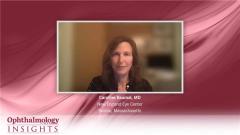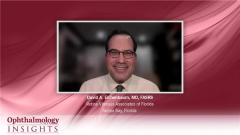
Incorporating Faricimab in Clinical Practice
Retina specialists discuss how to incorporate faricimab into clinical practice and discuss implacations of the TRUCKEE study.
Episodes in this series

Caroline Baumal, MD: David, I have a question for you. When you have a new agent available, how do you incorporate that into your clinical practice?
David A. Eichenbaum, MD, FASRS: You and I have collaborated on the real-world use of new agents in the past. We investigated and published on the real-world use of brolucizumab before, and we collected data on faricimab real-world use. When I look at the real-world experience within my practice, I use new agents on hard-to-treat patients first. That’s our natural predilection with the durability claims, and the durability data that we see for most of the new agents that do make it into the commercial marketplace. It’s natural to want to use them on the tougher patients, meaning the patients who need more frequent injections with existing agents to see if you can get more durability. Clearly, these patients would not be the patients in the clinical trials who are either treatment-naïve or well washed out. They’re not the clinical trial population, but they’re the ones we go to first because there are a lot in our practice, and we really want to give them a break. I feel badly bringing patients in every 4 or 6 weeks for frequent antiangiogenic injections.
With faricimab, because of our experience in the phase 2 and 3 trials—enrolling dozens of patients across multiple disease states for years and seeing the safety in the trials—even though we didn’t know the randomization, we didn’t know the treatment assignment. We did know that a lot of patients were getting faricimab in the trials, and we didn’t see a smoking gun of problems in the clinical trials over the past 6 years. I started using faricimab in treatment-naïve patients soon after its commercialization. I don’t have as much experience in treatment-naïve patients as in treatment-experienced patients because treatment-experienced patients are falling out of the trees. They’re falling like apples. Treatment-naïve patients trickle in at a lower percentage.
But I’m using faricimab now, which been out for over 6 months with over 70,000 commercial doses delivered, similar to how I use other established agents. I’m using it in treatment-naïve patients to test-drive it, to see if it works like TENAYA, LUCERNE, YOSEMITE, and RHINE. I’m using it in patients who haven’t achieved a bearable extension or a sufficient dryness using established antiangiogenic agents. Some of the diabetic agents I’ve used have kept patients a little boggy. I’m a big fan of corticosteroids, and I go to them for patients with diabetes who are boggy, as you taught me at the New England Eye Center, where corticosteroid therapy was widely published in the early 2000s. But the corticosteroid therapy just isn’t well suited to all patients. I’m trying to get better efficacy in these chronically slightly boggy patients with diabetes who are treatment experienced. I’m trying to get better extension in the patients with relatively dry and wet AMD [age-related macular degeneration], whom I can’t extend in the real-world use in my treatment-experienced population. In the treatment-naïve population, I’m test-driving PTIs [personalized treatment intervals]. I’m trying 4-week extensions. I’m seeing if I can duplicate the data from the clinical studies, including a load and an extension to see how close we can get in the real world to the result of the phase 3 registration trials. Is that how you’re using faricimab in the real world? Is that a similar approach to what you’re taking?
Caroline Baumal, MD: You brought up some good points. I want to clarify that in TENAYA and LUCERNE, only treatment-naïve neovascular AMD patients were enrolled. But in YOSEMITE and RHINE, up to 25% of eyes were treatment experienced. They had previously received anti-VEGF injections, and about 75% were treatment naïve. I’m looking forward to that data from YOSEMITE and RHINE to see how those patients did. I look at it in 2 ways. I look at patients who’ve responded well to what they’ve been using in the past before faricimab, but patients who want to have longer durability.
The other group I look at is patients who haven’t responded completely. In those patients, I may try faricimab to see if there’s an additional Ang2 effect, or maybe they’re not responsive at all. There are a small fraction of patients who don’t respond. For those patients, we wonder, is it the correct diagnosis? Is it something else that we’re not missing? Do they have a different type of disease? Overall, I have great faith in the clinical trials. Although I realize that ophthalmology trials—these were very large clinical trials of both for neovascular AMD and DME [diabetic macular edema]—are certainly not like cardiology trials, where they enroll 30,000 patients. Our trials are big for us because it’s hard to find so many patients who haven’t had previous treatment, but they’re global trials done all over the world on multiple sites. I have a lot of faith in how we do trials. I try to use the trials as a guide in the beginning. I’ve treated a lot of treatment-naïve patients with faricimab. They’ve had only a few injections because it’s still early in the game, but I’m pleased with the results I’ve seen.
David A. Eichenbaum, MD, FASRS: That’s a very similar real-world experience to what I’m enjoying. It’s important to note that when you talk about that small-error proportion of patients in YOSEMITE and RHINE who were treatment experienced—in up to 25% of the trials, around 22%, were treatment experienced—they were well washed out. They were at least 12 weeks from their last antiangiogenic injection. In the real world, I’m switching patients without washing them out. I’m not duplicating the clinical trial population in my treatment-experienced patients. In my treatment-naïve patients, I’m trying to do it the clinical trial way. TRUCKEE was a neat presentation because it showed us limited real-world data. It showed us a single injection’s worth of data, but the safety that was obtained from hundreds of patients in TRUCKEE with that single injection was fairly exquisite. We did see a suggestion of some improved efficacy. I’m curious to see how that data set evolves, how other real-world data sets are going to look, and how they stand up to the clinical trials.
Transcript edited for clarity
Newsletter
Don’t miss out—get Ophthalmology Times updates on the latest clinical advancements and expert interviews, straight to your inbox.


















































